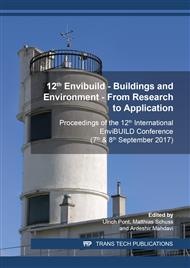p.156
p.164
p.172
p.181
p.189
p.196
p.204
p.212
p.219
On the Impact of Building Façades’ Color on Thermal Building Performance and Outdoor Thermal Comfort
Abstract:
A surface property of building façades, which has implications for thermal performance of buildings as well as outdoor thermal comfort, is visual reflectance. In this paper, the effects of façades’ visual reflectance on buildings' thermal performance and outdoor thermal comfort were investigated. A simulation tool was calibrated via empirical data and deployed to explore the impact of the visual reflectance of typical building façades in Vienna on indoor temperature and heating and cooling loads. The results show that the magnitude of visual reflectance has little impact on indoor temperature and energy demand of insulated buildings, while its effect on cooling load of non-insulated buildings is considerable. Finally, the effect of façades' visual reflectance on outdoor thermal comfort was investigated.
Info:
Periodical:
Pages:
189-195
Citation:
Online since:
January 2019
Authors:
Price:
Сopyright:
© 2019 Trans Tech Publications Ltd. All Rights Reserved
Share:
Citation:


